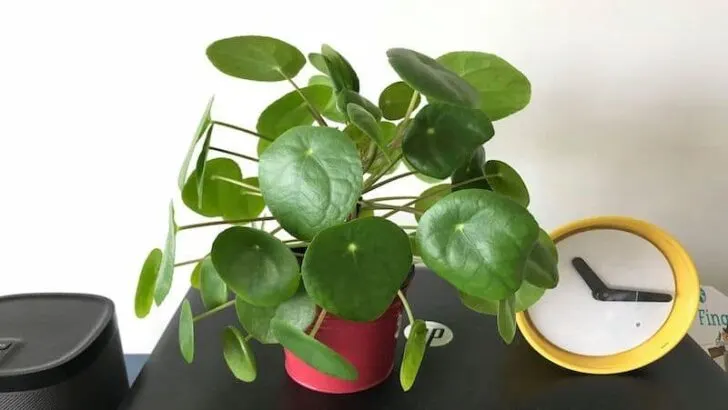The Pilea peperomioides or Chinese Money Plant is native to southern China, most commonly found in the Yunnan Province, and grows in forests at the foot of the Himalayas.
It offers round coin-shaped leaves with a remarkable bright green color and a glossy, waxy sheen.
Money Plants like Pilea peperomioides, Pachira aquatica, Crassula ovata (also called the Jade Plant) are generally considered lucky due to their good feng shui.
Known by the Latin name Pilea peperomioides, it is more commonly called Pilea, Chinese Money Plant, Pancake Plant, Friendship Plant, UFO Plant, or the Missionary Plant.
The genus Pilea belongs to the family Urticaceae with more than 200 species, according to the University of Florida.
Pilea peperomioides Takeaways
| Species | Pilea peperomioides |
| Synonyms | Pancake plant, Missionary plant, UFO plant, Leper plant, Mirror grass, Coin plant, Pass it on plant, Sharing plant, Friendship plant, Happy plant, Chinese rubber plant, Chinese coin plant, Chinese money plant |
| Family | Urticaceae |
| Genus | Pilea |
| Growth | Compact, clumping |
| Height | 1 foot |
| Width | 0.5 foot |
| Soil | Well-draining soil mix |
| Watering | Every 7 days |
| Light | Bright indirect |
| Temperature | 60-70 °F to 90 °F (16-21 °C) |
| Humidity | 40-60% |
| Fertilizer | Fertilize once a month in spring and summer |
| Propagation | Division or stem cuttings |
| Toxicity | This plant is non-toxic to cats and dogs as well as humans. |
Pilea peperomioides Care
Pilea peperomioides do best in all-purpose potting soil using 50% soil, 40% cactus mix, and 10% perlite. Water the plant once a week and provide bright indirect light. The temperature should be between 60°F to 86°F (16°C to 30°C). An average humidity between 40-50% is best. Fertilize using a liquid fertilizer at 1/4 strength in the growing season.
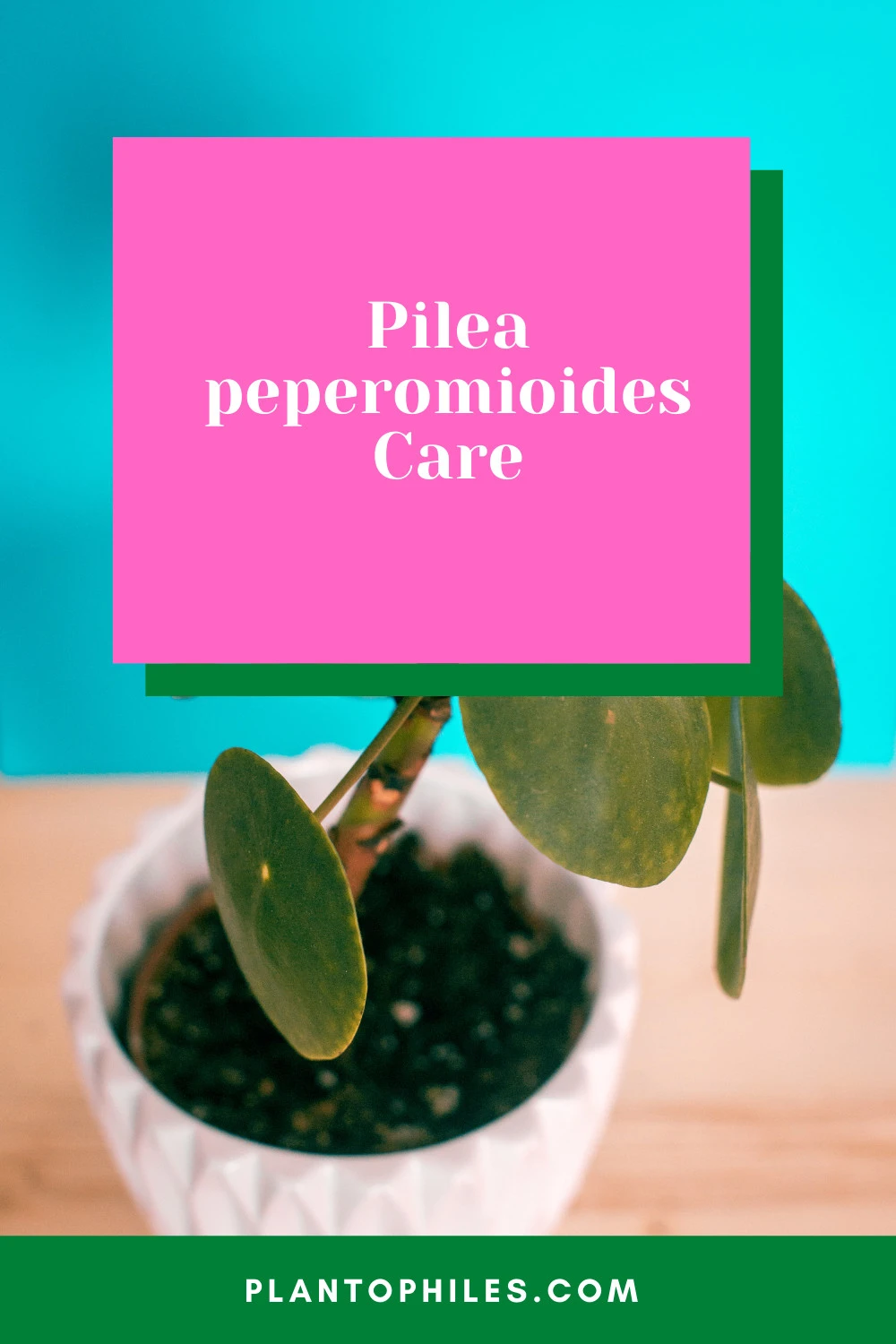
Table of Contents
Pilea peperomioides Care Guide
Pilea peperomioides do not require much maintenance, making it a popular pick for indoor plants!
Soil
Enjoys well-draining potting soil using 50% soil, 40% cactus mix, and 10% perlite. Avoid keeping the soil moist for longer durations.
To make sure that the soil is as per the requirement, push your index finger into the soil and see if it is sticky.
If the soil is sticking to your fingers, I suggest you wait at least two days before you water again.
Overwatering is one of the main reasons why most plants wilt, ultimately leading to their death.
As Pilea peperomioides need a well-draining mix, look for pots with tiny pores or holes underneath to allow excess water to trickle out from the soil.
And more importantly, ensure that there are no blockades near the pores, as this will defeat their purpose.
I like to use a premium mix of potting soil and then make it my own.
I create a mix of 50% premium potting soil, 40% cactus mix, and 10% perlite.
The cactus mix and the perlite provide the soil with a looser consistency that aids in water drainage.
Remember not to overdo the cactus mix, as this is not a desert plant, and it wants nutrients in the soil.
I add a lot of mulch, organic manure, peat, and pumice to enhance my potting mix. Chinese Money Plant soil tip:
Do not pack the soil tightly into the container to aid in soil aeration and drainage.
Terracotta is another material that can be used to pot your tiny Pileas.
Terracotta is porous, so the soil drains the excess water quickly.
However, potting it in a plastic or ceramic container is advised.
If you bought your plant in a terracotta one, re-pot it into a plastic or ceramic container, as suggested above.
You can also be clever and place the plastic container inside the terracotta vessel for aesthetics.
If you have a saucer under the pot, do not let water stagnate for more than a day.
Always eliminate stagnant water, as it can cause root rot, indefinitely ruining your entire venture.
Tight packing also clogs up the soil and reduces the water flow through the soil particles, so ensure your plant has well-dug-up soil.
The digging will also allow the roots to get fresh air from the atmosphere for regular nitrification.
Light
The Pilea peperomioides enjoy lots of bright indirect light.
But, it does not want to sit in direct sunlight.
If you are like me and think that every plant loves being in the sun, you will soon be disappointed to see that your plant is not happy.
Direct sunlight causes sunburn. The leaves show bleached spots and turn yellow.
The amount of light any window receives depends on several important factors.
Some factors are—the time of the year, the sun’s angle, whether you have an overhanging roof, or even maybe the tree shading the window.
The first thing you need to work on is finding the direction your window is facing.
If the sun shines into your room in the early hours, before noon, it is facing towards the East.
If you can feel direct sunlight coming in from the window, around the evening, or before the sun-set, your window faces the West.
If the sun never shines directly in through the window, then it is North faced and is not the ideal place to grow your plants.
And lastly, if your windows allow the sunlight to blaze in during the afternoons or late mornings, it faces the South.
As for me, I have found a great spot near my south-facing window.
It is bright but does not get direct sun.
You can even keep it on the east-facing window for the early trickling light of the sun.
This plant loves light, and you will see that the leaves tend to grow on the side that faces the light.
If it is left standing in the same position for a long time, you will have a lop-sided plant.
It may even topple over due to all the weight being on one side.
One of the experts at the nursery told me to rotate the plant every few days.
It will then produce stems and leaves in a lovely symmetrical pattern.
Also, if you are unsure about the light intensity your plant receives, try the ‘Shadow Test’ on it.
If you observe a dark shadow cast by your plant, it receives bright light.
However, if you feel the light is insufficient, you can buy a not-so-costly LED plant light.
The best part about an artificial light source is that you can set a timer so that your plant always receives the optimum light for the required period!
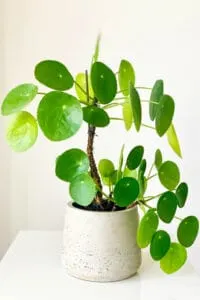
Watering
Water Pilea peperomioides every seven days in Spring and Summer.
It requires less water in Winter. The soil can remain slightly moist but must never be too soggy.
You should ensure that water does not stagnate near the roots of your Pileus, as it can cause the roots to rot.
Now and then, permit the soil to drain its moisture completely. This is even more important in Winter.
You don’t want your plant to stand in icy soil on a cold Winter’s night.
Even though the round coin-shaped leaves are its most fabulous feature, they also have a downside.
The large leaf surfaces easily collect dust.
The last thing you would want is dust particles making your bright green plant look pale and unattractive.
Mist spraying or washing off the leaves is a great way to clean off the dust and give the plant a fresh look.
If you are indoors, do this in the kitchen sink and run water lightly over the leaves.
Remember not to drench the pot with water, as it will defeat the purpose of this entire process.
If you do so by mistake, ensure the soil rids itself of the water.
Alternatively, you can also wipe the water down on the leaves with a damp cloth if you don’t want to make too much of a mess with water.
Most plants respond better to water that does not come from a tap.
Tap water is rich in volatile chemicals like fluoride and heavy metals. Therefore, it is always advised to use filtered or distilled water.
If you don’t have filtered or distilled water, boil water in a kettle and allow it to cool down for 24 hours before you use it.
Temperature
The Pilea peperomioides enjoy warm temperatures. It is most happy in a temperature range of 60°F to 86°F (16°C to 30°C).
It will not do well in temperatures constantly remaining below 50°F (10°C). It also doesn’t enjoy temperatures that fluctuate wildly.
Ensure that your environment remains within the required temperature range—even above it, if possible.
I have read on some websites that keeping the plant in cooler temperatures may encourage little white and pink flowers to go because it rarely produces.
I have not yet tried this. Perhaps I will re-pot one baby pup, keep it cold, and see how it goes.
Pro Tip—If you have your plant on a patio, consider bringing it indoors during winter.
Humidity
Grows best in average home humidity of around 40% to 50%.
While the Friendship Plant is not sensitive to humidity, we must remember that it is neither a desert plant nor a tropical plant—so extraordinarily high or low humid conditions are not ideal.
If you observe the leaves becoming crispier and losing their waxy texture, this could be because the plant is under low humidity.
Try to increase the humidity levels if possible. You can also give the plant a mist spray to create some dampness in the environment.
Like most plants, the Chinese Money Plant does not enjoy droughts. Don’t place it directly before an air conditioner or heating unit.
Fertilizer
Fertilize Pilea peperomioides monthly in spring and summer using a diluted liquid fertilizer art 1/4 strength.
However, use fertilization only during the Spring and Summer months and completely avoid it during the winter.
During its life cycle, a healthy mother plant will grow many baby plants that pop up from under the soil around it.
When you observe this phenomenon, you can give it a dose of extra fertilizer to strengthen the mother plant.
I suggest using only one-fourth to around half the strength of the recommended amount of the fertilizer or fertilizing periodically—like once a month or only in the springtime.
An all-purpose plant fertilizer will be ideal. Buy a packet from your local nursery or make your own.
I am maintaining an eco-friendly lifestyle wherever I can, so I stay away from chemical fertilizers. I like to purchase an organic mix.
When I have time, I mix peat, mulch, perlite, and crushed bark.
I also like to add some coco husks if I have them available.
Pro tip— Do not over-fertilize and make sure to reduce fertilizing in Winter. It is the rest period for the plant.
You can also use a time-release fertilizer— these fertilizers feed your plant as per its requirements without any external aid.
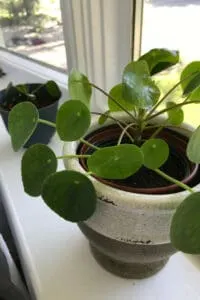
Pilea peperomioides Propagation
Pilea peperomioides can be propagated by cutting off the plantlets growing on the stem and in the soil.
The name Friendship Plant comes from an interesting fact – this plant was difficult to get hold of at one stage.
And, when it was found in a nursery, it was very expensive.
Because the plant self-propagates so easily, people would remove the babies, repot them and give them to friends as a gift.
This gave the plant its Friendship name and helped make the species far more accessible to plant lovers.
By cutting off the baby plants or rhizomes, you can easily propagate Pilea peperomioides at home.
Further, you will find my detailed guide on how to do this.
Growth
Pilea peperomioides grow in a pot to a height of around 8 inches to 12 inches (20cm to 30cm).
The Chinese Money Plant is super cute and can make you smile. New stems arise from a central stem and grow fairly long.
These stems carry leaves that are lovely pancake-shaped or coin-shaped. The leaves display a bright green color with a glossy waxy sheen.
Leaves can reach a size of 4 inches (10cm) in diameter. Because this plant loves light so much, it produces leaves on the side that gets the most light.
You will also see that existing stems tend to turn towards the light. Getting your plant to achieve that balance and symmetry is very easy – simply rotate your pot every alternate day or every 3 to 4 days.
The mother plants self-propagates by growing babies that pop out of the soil around them.
This can create an untidy-looking display. You can remove the babies carefully with a knife. The clear symptoms of a healthy pancake plant mostly include rich green leaves that are with a brisk texture.
The petioles of this plant are naturally long but it does not contain the tissue needed to grow a full-sized plant.
If the plant has been receiving adequate sunlight, it will not be elongated or yellow out. Another indication of a healthy UFO Plant is no brown decoloring on the outer boundaries of the leaves.
If you want to keep the ‘friendship’ going, why not re-pot and offer to family and friends as a gift?
Pilea peperomioides produces small white flowers with pink-tinted stems under a very healthy and happy condition but this might be rare.
Potting
Use a pot with draininage holes underneath for Pilea peperomioides so excess water can drain.
Pilea peperomioides are often used to enhance Scandinavian décor themed rooms.
That means a soft white, icy blue, or light pink pot! In reality, no matter what your décor theme is, the Pilea peperomioides look stunning in any decorative planter.
As discussed earlier, just remember to choose a certain pot that can help your plant drain its excess moisture.
The pot should have pores underneath its base.
This is vital to prevent water from remaining in the pot and causing the roots to rot.
Firstly, I like to put down crushed granite, just a thin layer of it, to allow the water to drain and give access to airflow.
Use an all-purpose potting soil and half-fill your pot.
Place your Chinese Money Plant into the center of the pot and fill the sides with soil using a scoop. Don’t pack the soil tightly.
Water well and stand in a bright spot with lots of light. Avoid direct sunshine.
Plastic containers that are tightly packed do not breathe and water can stagnate inside them.
They also add to the pollution levels of the planet as they are not biodegradable.
Pro tip— Stand your pot in an accessible position. This plant likes to be rotated every 3 to 4 days so that it maintains an even growth of leaves around the main stem.
Pilea peperomioides doesnt need to be repotted more than every 2-3 years.
What you might need to do is to cut off the little plantlets or baby pilea plants growing in the pot or else it might get too dense.
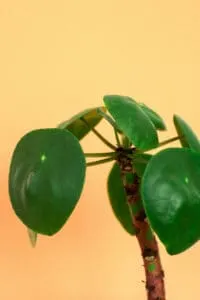
Pilea peperomioides in-depth propagation guide
Your Pilea peperomioides mother plant will soon start making babies that will start emerging around its base.
I usually re-pot them and give them to my cousins or friends giving it the much-deserved name of the Friendship plant.
I use a knife, with sharpened edges to lift the tiny plant and look around for its roots.
If the baby roots are well developed, I carefully cut them away from the mother plant, set them down in new potting soil, and water them ever so lightly.
The baby plants might be as small as an inch and take time to attain maturity, for a year or two, after which you can re-pot it to a bigger terracotta pot for regular cuttings.
You can also achieve a lush and full pot by planting multiple baby plants in one pot.
This could be done in two ways: Not removing the baby plants or planting multiple cuttings of the baby plants together.
Pilea peperomioides do not spread their wings by their main shoot.
So, in order to reproduce a whole family of Pilea peperomioides of your own, you would require multiple plants, as the plant has a moderately low rate of growth.
After a certain amount of time, the mother plant may also develop a central stem, making it look sort of like a Juniper or a Bonsai tree—although it won’t get much more than 15-16 inches tall and wide at most.
Propagate Chinese Money Plant from cuttings
- A healthy Pilea peperomioides will send up little plantlets through the soil around it
- When the baby plants reach a height of around 2 inches to 3 inches (5cm to 7cm), you can remove them using a sharp knife
- Always make sure that your knife is sterile
- Half fill your new pots with all-purpose potting soil
- You can work with the mother plant in its container itself
- Using your fingers, follow the stem of the baby plant for about 1 inch (2.5cm) under the soil
- Use the sterilized knife and cleanly cut the baby plant
- Carefully lift out the cut section of the plant and shake it off to remove the loosely hanging soil particles
- You can cut off some of the lower leaves to create a longer clean stem
- Place into the new container and fill up with soil
- You can prop up your baby with foam supports if required
- Place in a bright spot and keep the soil moist until you see new leaves appearing
- You may also see that new plants grow from the main stem of the mother plant
- You can remove these by holding them close to the stem and trimming them off
- Because they won’t have roots, place them into a glass of distilled water until you see small roots appear
- Now you can plant them into a pot filled with moist soil
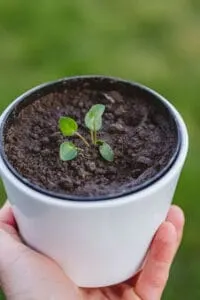
Common problems with Pilea peperomioides
Pest Control
Like most plants, your Pilea peperomioides plant may become a home for nasty pests.
It is your typical and the more household kind of pests that attack this plant like the mealybugs, fungus gnats, and spider mites.
If you are up to it, pests can be removed by hand. Wear gloves and gently pry them off the underside of the leaves where they tend to hide.
If this is not for you, spray your plant with a diluted solution of rubbing alcohol and then wash it off with a spray of clean water.
On a side note, I have found a natural pesticide that is easy to make and its ingredients can also be easily obtained.
It is made of oil and the Neem Plant.
The Neem plant has a strong and bitter taste that will naturally ward off pests.
Plant turns yellow
This is caused by too much direct sun or overwatering.
Move your plant into a spot that is bright but does not get direct sun.
Reduce watering if you see that your soil is constantly wet.
Leaves start curling inwards
Once again, this could be due to high sun exposure.
It could also be a result of the plant standing close to a heater, air conditioner, or fan.
Move your plant to a more suitable spot and it should improve.
Durability Issues
One of the consistent challenges with growing your own Pilea peperomioides can be the fact that you will soon find the plant to be quite delicate.
Its leaves are prone to splinter off relatively easily—so it is best to keep them somewhere your kids or pets can’t accidentally damage them.
White spots on the lower leaf surface
First, ensure that these are not pests. If they are not, then the spots are caused by deposits of heavy metals in the tap water you are using.
You should try to water your plant with distilled water or boiled water.
When using boiled water, allow the water to stand overnight.
Tips to grow Chinese Money Plant problem-free
- Plant into an all-purpose soil mix
- Do not overwater
- Soil can be slightly moist but should allow the moisture to settle down and dry out from time to time
- Keep in a bright spot with no direct sunlight
- Avoid very low or a place with a high amount of natural humidity
- Do not expose it to frost. Maintaining the right temperature is important
- Rotate after three to four days for an even amount of maturation on all sides
- Fertilize during Spring and Summer
- Fertilize when you see small plantlets appearing around the mother plant
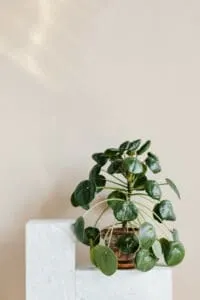
Frequently Asked Questions
Can the Pilea peperomioides grow indoors?
Pilea peperomioides can grow indoors. It looks stunning if you can plant it in a small pot where it offers a burst of bright green on its lovely round leaves. This is a very attractive indoor plant and makes a great gift to offer on a special occasion.
Is it easy to look after Pilea peperomioides?
Pilea peperomioides is a great choice for beginners. It only requires a bright spot, regular watering, and some care for regular rotation of the pot every other day. Fertilizing can be done in the growing season.
Is the Pilea peperomioides toxic?
Pilea peperomioides is not considered toxic but it still might cause an allergic reaction. It also does not have spikes, spines, or sharp edges, which automatically makes it the perfect choice for a home with pets or children.
How much does Pilea peperomioides cost?
Depending on the region and on its availability in that region, the Pilea peperomioides can cost up to $50. But usually, you should be able to get a Pilea peperomioides between $10-$20. You can browse Amazon or other online stores and get an idea of the pricing range.
The last Pilea
According to a National Gardening estimate in 2016 the United States, six million new Americans took up gardening in 2015 with five million of them being millennials.
Pilea peperomioides, thanks to their popularity, are now grown all around the world.
It has become the most in-demand and talked-about house plant in recent years across the US and around the world.
It’s a pretty fascinating story.
This Chinese species, right under the nose of the western sciences, spread across thousands of homes in Europe just by the baby plants being passed from family to friends.
It’s quite reassuring to think that domestication can ensure the survival of scarce wild plants like Pilea peperomioides.
The Friendship Plant will make you smile. It has a fabulous bright green color and gorgeous pancake-shaped leaves.
It makes an attractive display on a shelf or accent table a little distance away from a window.
Maybe, this is exactly what you have been looking for to get your hand on a touch of nature to bring home with a Pilea peperomioides.

Daniel has been a plant enthusiast for over 20 years. He owns hundreds of houseplants and prepares for the chili growing seasons yearly with great anticipation. His favorite plants are plant species in the Araceae family, such as Monstera, Philodendron, and Anthurium. He also loves gardening and is growing hot peppers, tomatoes, and many more vegetables.

